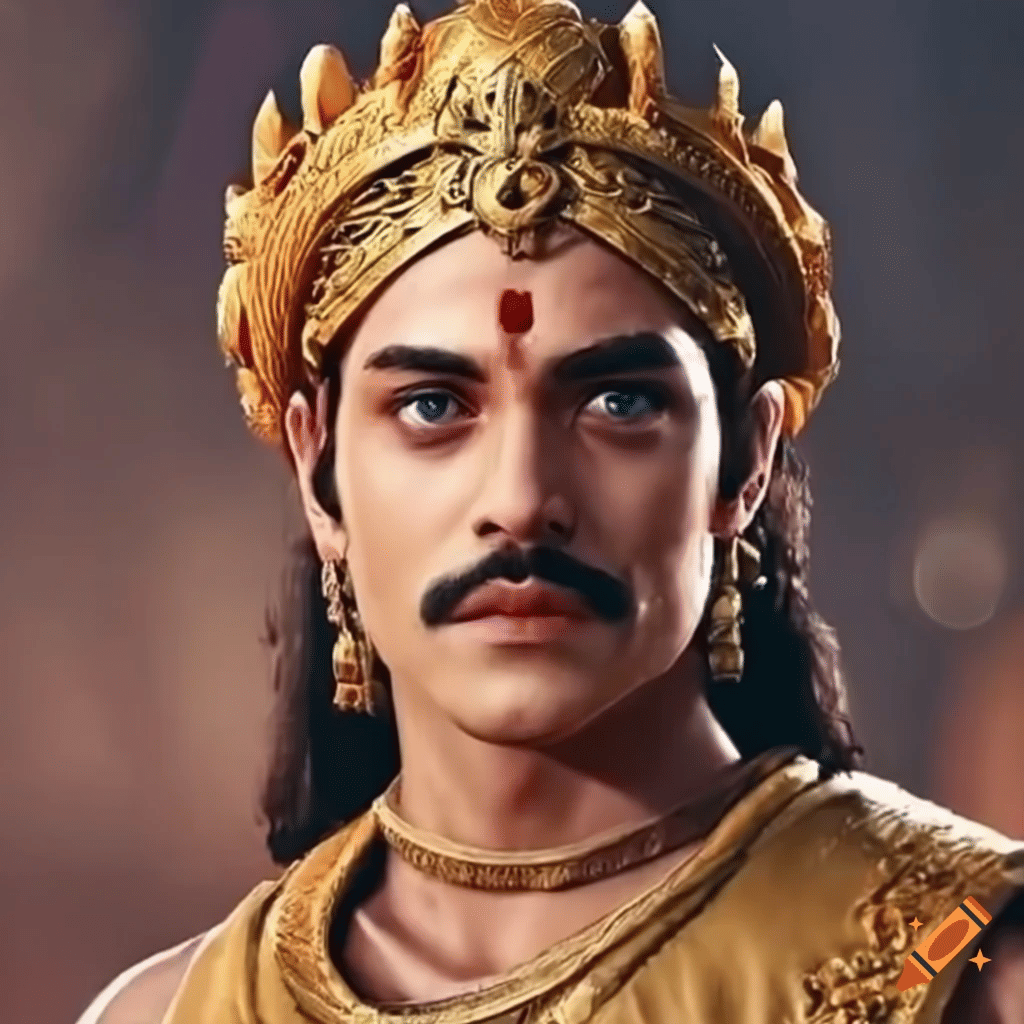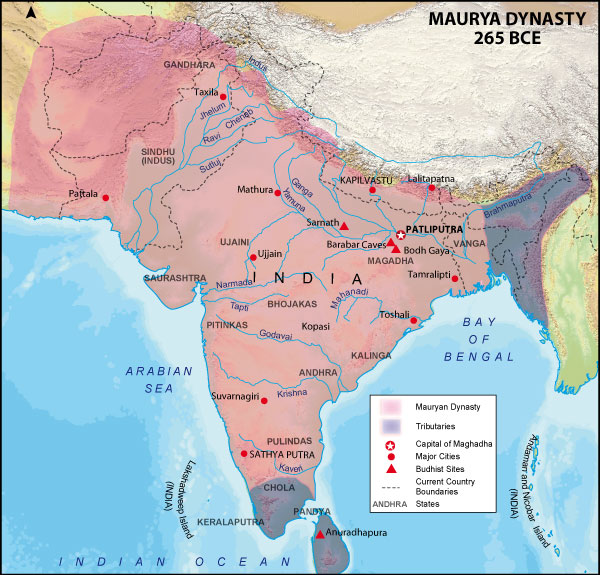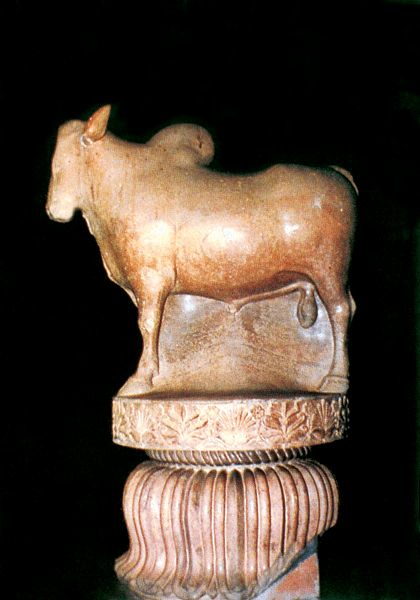Class 6 History Chapter 7 Notes - From a Kingdom to an Empire
| Table of contents |

|
| The Empire Geography |

|
| How are Empires Different from Kingdoms? |

|
| Ruling the Empire |

|
| Ashoka, a unique ruler |

|
| Ashoka’s War in Kalinga |

|
| What was Ashoka’s dhamma? |

|
Imagine a king inheriting a massive empire across India, Pakistan, and Afghanistan, expecting happiness. Winning battles and achieving fame, but something seemed off after every conquest. Then suddenly after one such battle, the king was shaken. he couldn't shake off the cries of the soldiers he defeated and the smell of death that stuck to him like a bad dream. What he decided next shocked everyone around him.
This king is one of the greatest conquerors of Ancient India, Ashoka, the great. His fame is not great because of the lands he conquered but because of the kindness he showed in the later stages of his rule.
 Ashoka, the Great
Ashoka, the Great
The powerful lions we see on our money have their origins linked to Ashoka.. They were skillfully carved from stone and proudly placed on a massive pillar in Sarnath, standing as symbols of strength and heritage.
Ashoka the Great holds an important place in Indian history. His life has been followed by many, and students must learn about him to gain insights into life’s meaning. Ashoka was one of the greatest rulers known to history, and on his instructions, inscriptions were inscribed on pillars and rock surfaces.
- Ashoka was one of the greatest rulers of history ruled-empire founded by his grandfather, Chandragupta Maurya, over 2300 years ago.
 Arthashastra
Arthashastra
- He was supported by a wise man named Chanakya or Kautilya. Chanakya’s ideas were written down in a book called the Arthashastra.
Dynasty:When members of the same family become rulers one after another, the family is often called a dynasty. The Mauryan Dynasty had rulers like Chandragupta Maurya, Bindusara, Ashoka and their descendants.
- Chandragupta brought together different kingdoms.
- Bindusara made the territory bigger.
- Ashoka changed everything.
The Empire Geography
Several cities in the empire included the capital Pataliputra, Taxila, and Ujjain
- Pataliputra stood proud on the banks of the Ganges. Traders sold things in busy markets, skilled workers made beautiful items, and smart people talked in large halls. It was like a small version of the empire.
- In the northwest, Taxila was an important entrance to Central Asia. Greek travelers were impressed by its universities and good trade. It was a place where ideas and goods moved easily, connecting East and West.
- In the south, Ujjain was busy, connecting the north and south. Traders with spices and clothing came and went, and artists and poets enjoyed themselves in the city.
- In other areas, there were villages of farmers and herders. In central India, there were forests where people gathered forest produce and hunted animals for food.
- The languages in the empire were as different as the lands. Common people spoke Prakrit, while the grand Sanskrit was used in the courts.
 Mauryan Empire
Mauryan Empire
How are Empires Different from Kingdoms?
Kingdoms are like smaller countries ruled by a king or queen, usually passing power within their family.The emperor has powers such as:
- Emperors need more resources than kings as they have larger land.
- Emperors need to be protected by big armies.
- Emperors also need a larger number of officials who collect taxes.
Ruling the Empire
Large empires in different parts were ruled differently. Ashoka's empire covered a large area from the fertile plains of the Ganges to the mountains in the northwest, including a mix of cultures and customs. Ashoka managed to rule this with a proper system maintained by his advisors.
1. Centralized Control under the Emperor's Gaze:
- In the center of the empire, near Pataliputra, the emperor had control.
- Loyal officials managed taxes, maintained order, and made sure people followed his commands.
- Messengers traveled back and forth, sharing updates regarding law and order, while spies watched for any problems.
- Trusted family members and advisors, including Chanakya, supported Ashoka in this important center, making sure everything worked well in his inner circle.
2. Provincial Rule:
- As we move from the main center of the empire, the control over power becomes less strict.
- In places like Taxila and Ujjain, governors or royal princes had power.
- Even though they recognized Pataliputra's control, they also kept some independence.
- This system allowed them to have complete control over the empire.
3. Controlling Trade and Resources:
- The Mauryas focused on protecting important paths like roads and rivers essential for trade and communication.
- Chanakya's book, the Arthashastra, shows their planned interest in areas with a lot of resources.
- The northwest provided warm blankets, and south India gave gold and valuable stones.
4. Navigating Tributary Relationships:
- Ashoka understood the power of people living in forests.
- He talked to them and set up a trade where they provided things like wood, honey, wax, and even elephants.
- In exchange, Ashoka provided them with protection.
Tribute
Unlike taxes, collected on a regular basis, tribute was collected as and when it was possible from people who gave a variety of things, more or less willingly.
Ashoka, a unique ruler
Famous Mauryan ruler Ashoka was the first ruler who tried to take his message to the people through inscriptions. These inscriptions were in Prakrit and written in the Brahmi script.
- Winning battles and achieving fame, but something seemed to bother him after every conquest.
- His fame is not great because of the lands he conquered but because of the kindness he showed in the later stages of his rule.
- But all this change was seen in Ashoka after the great battle of Kalinga.
- Ashoka's life has been followed by many to gain insights into life’s meaning.
- Ashoka was one of the greatest rulers known to history.
Ashoka’s War in Kalinga
- Kalinga was the ancient name of coastal Orissa.
- Ashoka fought a war to conquer Kalinga.
- He was horrified when he saw the violence and bloodshed and so decided not to fight any more wars.
- The king made a life changing decision which was the first in the complete history.
- Even after having a powerful army, the king decided not to invade its neighbouring lands.
Ashoka was the only king in the history of the world who gave up conquest after winning a war.
What was Ashoka’s dhamma?
 The Rampurwa Bull- Polished stone structure was a part of Mauryan Empire
The Rampurwa Bull- Polished stone structure was a part of Mauryan Empire
Ashoka's Dhamma did not involve the worship of a god or the performance of a sacrifice. He had a duty to instruct his subjects and was also inspired by the teachings of the Buddha.
A number of problems troubled him.
- People in the empire followed different religions, which led to conflict.
- Animals were sacrificed.
- Slaves and Servants were ill-treated.
- Quarrels in families and amongst neighbours.
Ashoka’s duty was to solve these problems. He tried to solve them by several ways.
- He appointed officials, known as the dhamma mahamatta, who went from place to place teaching people about dhamma.
- His messages were inscribed on rocks and pillars.
- He instructed his officials to read his message to those who could not read it themselves.
 The Brahmi script Most modern Indian scripts have developed from the Brahmi script over hundreds of years. Here you can see the letter ‘a’ written in different scripts
The Brahmi script Most modern Indian scripts have developed from the Brahmi script over hundreds of years. Here you can see the letter ‘a’ written in different scripts - He also sent messengers to spread ideas about dhamma to other lands, such as Syria, Egypt, Greece and Sri Lanka.
Ashoka sent his son(Mahendra) and his Daughter(Sanghmitra) to Sri Lanka to spread his Dhamma
- He built roads, dug wells, and built rest houses and arranged for medical treatment for both human beings and animals.
|
67 videos|386 docs|80 tests
|
FAQs on Class 6 History Chapter 7 Notes - From a Kingdom to an Empire
| 1. How are Empires different from Kingdoms? |  |
| 2. Who was Ashoka and why is he considered a unique ruler? |  |
| 3. What was Ashoka's dhamma and how did it shape his rule? |  |
| 4. What was the significance of Ashoka's war in Kalinga? |  |
| 5. How did Ashoka rule his empire and what were some of his accomplishments? |  |

|
Explore Courses for Class 6 exam
|

|



















